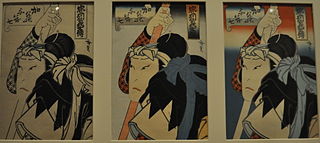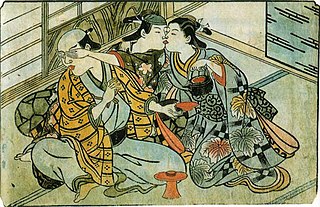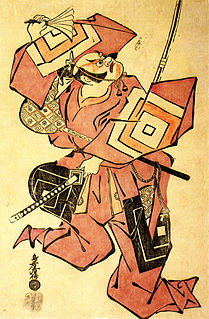 W
WKabuki (歌舞伎) is a classical form of Japanese dance-drama. Kabuki theatre is known for its heavily-stylised performances, the often-glamorous costumes worn by performers, and for the elaborate kumadori make-up worn by some of its performers.
 W
WActor Ichikawa Shikō as Katō Yomoshichi from the series Tales of Retainers of Unswerving Loyalty is an ukiyo-e woodblock print by Osaka-based late Edo period print designer Gosōtei Hirosada (五粽亭廣貞). Each of the three sheets contains a different version of the same image, reflecting progressive stages in the woodblock printing process. The print is a portrait of a contemporary kabuki actor in the role of a samurai, and belongs to a series of images of heroes. The print belongs to the permanent collection of the Prince Takamado Gallery of Japanese Art in the Royal Ontario Museum, Canada.
 W
WThe Actors' Analects is a collection of 17th and early 18th century writings on the practice and aesthetics of acting in Japan's kabuki theatre form, compiled during or around the Genroku era (1688-1704). Though not providing much direct information about the origins or history of the development of kabuki in prior periods, the works collected were written at a time when many of the standards of kabuki were being established and formalized; the work thus reflects the philosophies and aesthetics of one of kabuki's most formative periods. One of the earliest extant versions was originally published in 1776, as a set of woodblock printed books in four volumes. It is unclear whether the Analects were printed as a collection before this time, but references to the "seven writings" indicate that the works were considered together as a group, even if they were not published in such a fashion, since their creation in the early 18th century.
 W
WAragoto (荒事), or rough style, is a style of kabuki acting that uses exaggerated, dynamic kata and speech. Aragoto actors typically wear bold red or blue makeup, and have costumes that are padded and enlarged. The term "aragoto" is an abbreviation of the term "aramushagoto", which literally means "wild-warrior style".
 W
WBanchō Sarayashiki is a Japanese ghost story (kaidan) of broken trust and broken promises, leading to a dismal fate. Alternatively referred to as the sarayashiki tradition, all versions of the tale revolve around a servant, who dies unjustly and returns to haunt the living. Some versions take place in Harima Province or Banshū (播州), others in the Banchō (番町) area in Edo.
 W
WBotan Dōrō is a Japanese ghost story (kaidan) that is both romantic and horrific; it is one of the most famous kaidan in Japan. The plot involves sex with the dead and the consequences of loving a ghost.
 W
WThe hanamichi (花道) is an extra stage section used in Japanese kabuki theater. It is a long, raised platform, running left of centre to the stage through the audience, connecting to the main stage.
 W
WA hayashi (囃子) is a group of performers who provide musical accompaniment for Japanese Nō or kabuki theatre, yose performances of rakugo, or a festival.
 W
WOkuni was a Japanese shrine maiden who is believed to have invented the theatrical art form of kabuki. She is thought to have begun performing her new art style of "kabuki" theatre in the dry riverbed of the Kamo River in Kyoto. Okuni's troupe quickly gained immense popularity, and were known for their performers, who were often lower-class women Okuni had recruited to act in her all-female theater group.
 W
WA kabuki brush is a makeup brush with dense to fluffy bristles and most recognizably has a short handle. The brush head is most often rounded, though it can also be flat. Traditionally, the bristles are made of natural materials like animal hair, but most brushes available now on the market have synthetic bristles.
 W
WKabukibu! is a light novel series written by Yūri Eda, with illustrations by Ishinoya. The series began on August 24, 2013 and has since collected five volumes, published by Kadokawa Shoten as of December 2016. The series is about Kurogo Kurusu, a boy who is obsessed with kabuki and decides to form a kabuki club at his high school. A manga adaptation by Chizu Kamiko is being serialized on Kadokawa Shoten's Young Ace since March 2017. A 12-episode anime television series adaptation by Studio Deen, aired between April 6, 2017 and June 22, 2017.
 W
W'Kagema' (陰間) is a historical Japanese term for young male sex workers. Kagema were often passed off as apprentice kabuki actors and catered to a mixed male and female clientele. For male clients, the preferred service was anal sex, with the client taking the penetrative role; homosexual fellatio is almost unmentioned in Tokugawa-era documents.
 W
WKumadori (隈取) is the stage makeup worn by kabuki actors, mostly when performing kabuki plays in the aragoto style. The term also applies to a painting method in which two brushes are used simultaneously, one for the color and the other used to create shading or other details.
 W
WKunisaki Izumo no Jijō is a Japanese manga series written and illustrated by Aya Hirakawa. It was serialized in Shogakukan's Weekly Shōnen Sunday magazine from January 2010 to March 2014, with its chapters collected in nineteen tankōbon volumes. Two drama CDs were bundled with the 7th and 11th volumes of the manga in 2011 and 2012 respectively.
 W
WKuroko are stagehands in traditional Japanese theatre, who dress all in black.
 W
WThe mie, a powerful and emotional pose struck by an actor, who then freezes for a moment, is a distinctive element of aragoto Kabuki performance. Mie means 'appearance' or 'visible' in Japanese, and one of the primary purposes of this convention is to draw attention to a particularly important or powerful portion of the performance. It is meant to show a character's emotions at their peak, and can often be a very powerful pose. The actor's eyes are opened as wide as possible; if the character is meant to seem agitated or angry, the actor will cross his eyes. In Japanese, the mie pose is said to be "cut" by the actor. Audience members will shout out (kakegoe) words of praise and the actor's name at specific times before and after the pose is struck.
 W
WNagauta is a kind of traditional Japanese music which accompanies kabuki theater. It was developed around 1740. Influences include the vocal yōkyoku style used in noh theater, and instruments include the shamisen and various kinds of drums. The music is a combination of different styles stemming from the music popular during the Edo period.
 W
WNakazō I Nakamura , also known as Hidetsuru or Sakaeya, was a Japanese kabuki actor.
 W
WOnnagata or oyama are male actors who play female roles in Japanese Kabuki theatre.
 W
WLeonard Cabell Pronko was an American theatre scholar best known for introducing the Japanese dance drama kabuki to the West, beginning in the 1960s. He was a professor of theatre at Pomona College in Claremont, California, where he taught from 1957 to 2014.
 W
WSgt. Kabukiman N.Y.P.D. is a 1990 superhero comedy film directed by Lloyd Kaufman and Michael Herz and distributed by Troma Entertainment.
 W
WShosagoto (所作事) or furigoto (振事), also known as dance or dance-drama, is a type of kabuki play based on dance. It is one of the three genres of kabuki, together with jidaimono and sewamono.
 W
WShūmei are grand naming ceremonies held in kabuki theatre. Most often, a number of actors will participate in a single ceremony, taking on new stage-names.
 W
WTwo Actors in Samurai Roles from the series "Tales of Brave Warriors of Renown" is an ukiyo-e woodblock print diptych by Osaka-based late Edo period print designer Gosōtei Hirosada (五粽亭廣貞). Each sheet depicts a kabuki actor as a samurai, and belongs to a series of prints celebrating illustrious figures in Japan's martial tradition. The print belongs to the permanent collection of the Prince Takamado Gallery of Japanese Art in the Royal Ontario Museum, Canada.
 W
WYakusha-e (役者絵), often referred to as "actor prints" in English, are Japanese woodblock prints or, rarely, paintings, of kabuki actors, particularly those done in the ukiyo-e style popular through the Edo period (1603–1867) and into the beginnings of the 20th century. Most strictly, the term yakusha-e refers solely to portraits of individual artists. However, prints of kabuki scenes and of other elements of the world of the theater are very closely related, and were more often than not produced and sold alongside portraits.
 W
WZa Kabuki, founded in 1976 at the Australian National University, is the longest running Kabuki troupe outside Japan. Directed by Shun Ikeda of the ANU Japan Centre, with a cast and crew consisting mainly of ANU Japanese students, the troupe performs traditional Kabuki plays almost entirely in classical Japanese, with some English translation and ad-libs inserted to assist the mainly English-speaking audiences.